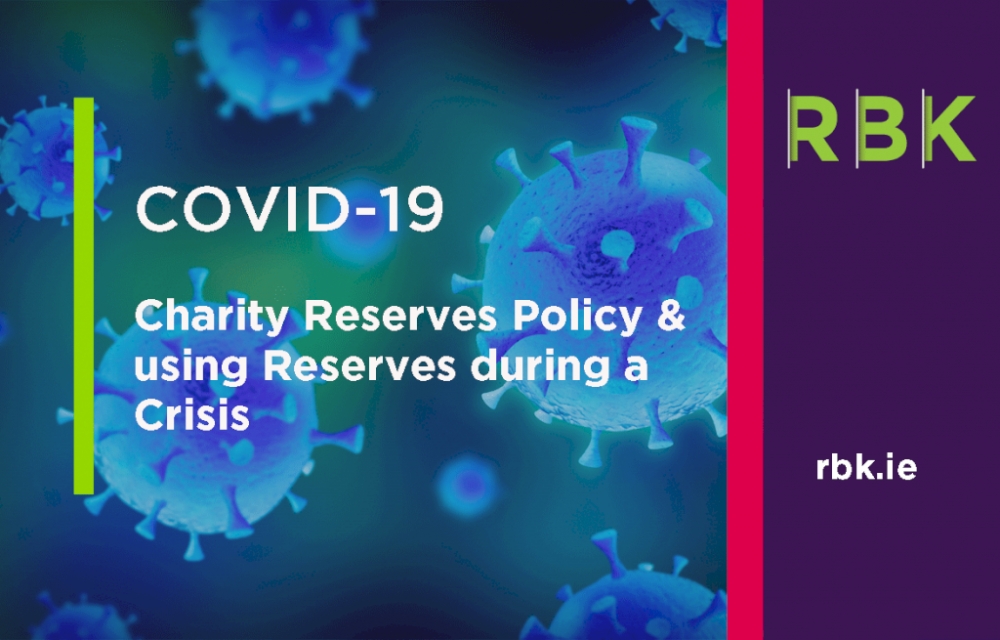On the 13th May the Charity Regulator Authority (CRA) issued a guidance document “Guidance on Charity Reserves” . the purpose of which is to provide support to charity trustees:
- on the meaning of the term “reserves”,
- how to determine the most appropriate level of reserves
- the benefits of establishing a reserves policy,
- how to develop a policy for managing and reporting on reserves
- the use of reserves in an emergency such as during the current pandemic.
What are reserves?
Generally, reserves are the surplus funds that a charity has built up over a number of years and which can be freely spent on any of its charitable purposes. Any restricted surpluses must be excluded from the calculation as these must be used for specific purposes as specified by the donor.
Why hold reserves?
A Charity is expected to spend its income on its charitable purpose, which includes delivering its activities or services, unless there is a specific reason for retaining it. The main reasons why charities try to build up reserves is:
- Maintain financial stability and fund working capital,
- Meet its commitments if there are unexpected cost overruns or if the receipt of income is delayed,
- Fund a specific commitment or project
- To maintain a buffer for an unexpected crisis such as the current pandemic
Why have a reserves policy?
An appropriate level of reserves will safeguard the charity from future shock events and demonstrate that the trustees are exercising appropriate governance oversight.
A reserves policy is a key tool to assist with this process and is part of the recommended suite of internal financial controls which should be in place.
Such a policy allows Charity’s to explain to their donors and key stakeholders what their desired level of reserves is and plans to reach the target where reserves are below the desired level. Similarly, if there is an accumulation of reserves, a reserves policy allows an explanation to be given as to how any excess will be utilised in the future.
What should be included in a reserves policy?
There are no hard and fast rules for writing a reserves policy. Each Charity, based on its own scale and complexity will have different requirements. However, the guidance note outlines certain best practice considerations which include the following:
- Reasons for having reserves or if the charity has opted not to hold excess reserves the rationale for this
- Steps taken by the charity to establish the required level of reserves,
- The level of reserves required,
- The strategy for building an appropriate level of reserves,
- How the policy is monitored and reviewed,
- How the policy will be communicated to donors and various stakeholders
What is an appropriate level of reserves?
The guidance note recognises that this will be unique for each individual charity. However, consider:
- The size of the charity including income levels, and reliance on funders for that income
- Future planned expenditure levels and contractual obligations to funders, suppliers and other stakeholders
- Employer obligations
The precise level of reserves and how these will be used is ultimately a matter for the trustees. These can be expressed as a specific monetary amount or it may reflect a number of months operating expenditure. Trustees need to consider the following as greater levels of uncertainty may require higher levels of reserves:
- The requirement to plan for unforeseen emergencies or day to day operational costs
- Loss of a key donor
- An increase in services or supports to the Charity’s beneficiaries
- The likelihood that there will be a mismatch between the timing of expenditure and the related income
How to use reserves in a crisis
During a crisis such as during the current Covid-19 pandemic, managing a charity can be a challenging and worrying time. Reserves are there to be used in situations like this and trustees should consider:
- Short, medium and long term plans and what changes are required to financial planning
- Whether future projects can be postponed or curtailed to focus on essential costs
- Review of reserves which have been given a specific internal designation and where possible release these to reallocate for more immediate use
- Ensure that the Charity does not take on a debt that I cannot repay
Conclusion
It is important that all Charity’s consider the requirement for reserves and formulate this in a Board approved policy. This policy should be reviewed at regular intervals to ensure it remains appropriate, especially in the current evolving pandemic environment.
It is also important that charity trustees use the Directors report to communicate effectively with all stakeholders – Funders, Beneficiaries and the general public as to what steps the Charity is taking to ensure good financial management and safeguard the assets of the charity via the holding of reserves. This includes an adequate explanation for any gap between the desired levels of reserves and reserves actually held.
How RBK can help:
If you need any further assistance in relation to the Reserves Policy and using Charity Reserves during a crisis, please contact your usual RBK contact, in confidence, or please contact our team on (01) 6440100 / (090) 6480600:
- Ronan Kilbane, Partner
- Michelle O'Donoghue, Director
- Evelyn Smyth, Senior Manager


